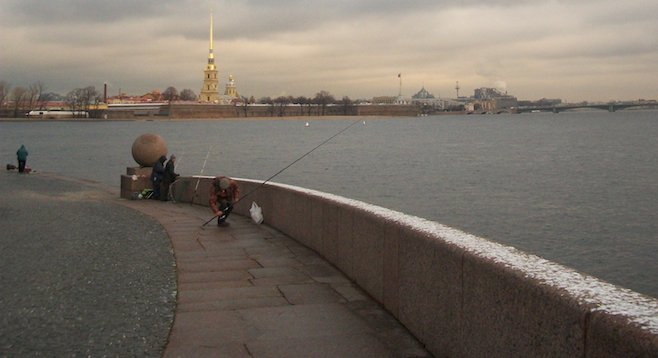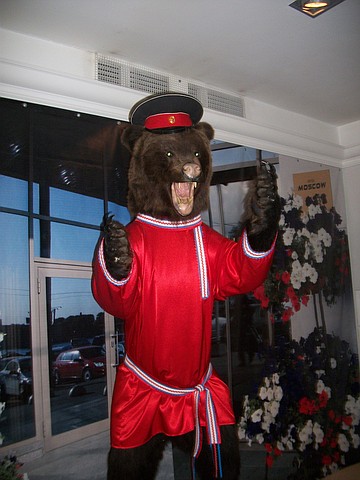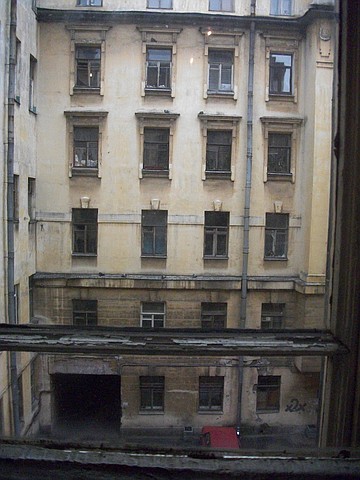 Facebook
Facebook
 X
X
 Instagram
Instagram
 TikTok
TikTok
 Youtube
Youtube

Exhaustion from traveling had taken its toll. I craved sleep, but was not comforted by the platform posing as a bed, shaking as the night train made its way south to Moscow.
Sightseeing in the bitter November cold, coupled with drinking copious amounts of vodka and eating Russian treats like reindeer and caviar, joined forces to make me sick. The cough medicine I purchased in a tiny pharmacy did little to soothe my lungs (the main ingredient, according to my professor, could be translated to “the plant that grows on the side of the road”).
I grew increasingly ill when I thought about how, instead of a glass of wine with dinner, Russians take shots of vodka (which means “little water”). I tried to keep my lungs and stomach quiet by ruminating over the first half of my Russian adventure.
Saint Petersburg was the first city we visited and, on one side, it is filled with opulence dating back to tsardom. My group, made up of fifteen students studying abroad in Copenhagen, began the trip with a visit to the Hermitage Museum, a mint-green palace the royal family occupied a century ago. Now it is an art museum with a collection so grand it rivals the Louvre.
Walking up the staircase at the entrance, I pictured Anastasia prancing down singing about Russia (although she was much less of a Disney princess than I’ve grown up imagining). She met a brutal end when she was murdered by the Bolshevik police in 1917. The Hermitage Museum has a rich collection of Russian armor, royal jewelry and silverware Peter the Great probably ate his borsht soup with. One dish plated with gold and encrusted with rubies was labeled “sausage plate.”
Another experience of Russian magnificence: the Mariinsky Theatre, a building that oozed lavishness. The evening I saw Tchaikovsky’s Romeo and Juliet ballet, women sitting in the box seats wore furs from the sleekest minks and their highest stilettos. Although it was November and a layer of ice covered most streets, nearly every young woman wore tall, high-heeled boots – which matched well with the heavy, dark eye makeup that their razor-straight bangs framed perfectly.
The story of Romeo and Juliet may be old news in terms of plot, but I watched the whole production on the edge of my seat. The ballerinas exuded a perfect balance of strength and gracefulness unlike anything I’ve seen. While the audience gave a shower of applause at the end, no one was more pleased than the dancers themselves. Sinewy, brunette Juliet and her leotard-clad Romeo came back on the stage eight times. I giggled as we watched the audience file out and the dancers re-enter the stage to soak up the last bit of applause.

At breakfast the next morning, the group spoke about our upcoming walking tour of Saint Petersburg. I was only half paying attention – my eyes had wandered to the stuffed brown bear decorating the dining room.
It was standing up, eight feet tall, exposing all its teeth, and wearing a bright red bathrobe with matching cap. Despite the distraction, I caught that the tour was meant to look “behind the façade” of the city.
The class was split up into groups and paired with Russian students who had offered to show us around. A hard-faced woman named Tatiana was my guide. Although she was young, Tatiana did not fit the typical “high heels and lots of makeup” look, but, like most Russians, she hardly smiled.
Our group squished into a 1950s-style bus that wound through the glitzy lights of downtown and towards the suburbs. As the group filed off the bus, Tatiana told us we were about to see “typical Russian housing.” Over 75% of the people in Saint Petersburg live in these kommunalkas.

We entered an ordinary-looking grey building and an eerie chill filled the air. A single light bulb dangled precariously on a wire from the ceiling; the smell of damp mold and dust crept over us like a fog. Stapled onto the wall above the doorframe were about 50 loose extension cords clumped in patches, sprawling out in different directions like jellyfish tentacles. We passed the fire hazard and headed up a flight of creaky wooden stairs.
After going up four flights in the semi-darkness, we arrived in a musty hallway devoid of windows. Tatiana stopped abruptly at a featureless door and knocked. A short, blonde man opened the door and warmly welcomed us in.
Entering the kommunalka was like jumping back into an era I had read about in textbooks. The apartment had four bedrooms and housed twelve people. The man who lived there shared a bedroom with his parents and brother. All twelve shared the kitchen and bathroom.
Upon entering, we were immediately intruding in another’s home, so the man quickly took us into his “house.” It was the size of a typical bedroom, about 12’ by 12’, but two large, white fabric dividers split the room in half. A desk in the back corner accommodated a few family photos and, had I been able to proficiently read Cyrillic, I would know which books littered the desk and floor.
The son’s side of the home barely fit two beds and a full drum set. The man (who was 29, but remains nameless in my mind) animatedly told us that his older brother had started sleeping at his girlfriend’s. His enthusiasm dwindled when he told us that he still had to fit nine other schedules around his drumming practice.
As we braved the November air upon exiting the kommunalka, Tatiana told us, “Once you live here you can never leave. Housing in Saint Petersburg is expensive, and there are few open apartments. My parents have wished to leave our kommunalka for years. It is not possible. We stay in kommunalka for generations.”
Back on the train, I dozed off as the train continued on towards Moscow, wondering what curious contradictions awaited.


Exhaustion from traveling had taken its toll. I craved sleep, but was not comforted by the platform posing as a bed, shaking as the night train made its way south to Moscow.
Sightseeing in the bitter November cold, coupled with drinking copious amounts of vodka and eating Russian treats like reindeer and caviar, joined forces to make me sick. The cough medicine I purchased in a tiny pharmacy did little to soothe my lungs (the main ingredient, according to my professor, could be translated to “the plant that grows on the side of the road”).
I grew increasingly ill when I thought about how, instead of a glass of wine with dinner, Russians take shots of vodka (which means “little water”). I tried to keep my lungs and stomach quiet by ruminating over the first half of my Russian adventure.
Saint Petersburg was the first city we visited and, on one side, it is filled with opulence dating back to tsardom. My group, made up of fifteen students studying abroad in Copenhagen, began the trip with a visit to the Hermitage Museum, a mint-green palace the royal family occupied a century ago. Now it is an art museum with a collection so grand it rivals the Louvre.
Walking up the staircase at the entrance, I pictured Anastasia prancing down singing about Russia (although she was much less of a Disney princess than I’ve grown up imagining). She met a brutal end when she was murdered by the Bolshevik police in 1917. The Hermitage Museum has a rich collection of Russian armor, royal jewelry and silverware Peter the Great probably ate his borsht soup with. One dish plated with gold and encrusted with rubies was labeled “sausage plate.”
Another experience of Russian magnificence: the Mariinsky Theatre, a building that oozed lavishness. The evening I saw Tchaikovsky’s Romeo and Juliet ballet, women sitting in the box seats wore furs from the sleekest minks and their highest stilettos. Although it was November and a layer of ice covered most streets, nearly every young woman wore tall, high-heeled boots – which matched well with the heavy, dark eye makeup that their razor-straight bangs framed perfectly.
The story of Romeo and Juliet may be old news in terms of plot, but I watched the whole production on the edge of my seat. The ballerinas exuded a perfect balance of strength and gracefulness unlike anything I’ve seen. While the audience gave a shower of applause at the end, no one was more pleased than the dancers themselves. Sinewy, brunette Juliet and her leotard-clad Romeo came back on the stage eight times. I giggled as we watched the audience file out and the dancers re-enter the stage to soak up the last bit of applause.

At breakfast the next morning, the group spoke about our upcoming walking tour of Saint Petersburg. I was only half paying attention – my eyes had wandered to the stuffed brown bear decorating the dining room.
It was standing up, eight feet tall, exposing all its teeth, and wearing a bright red bathrobe with matching cap. Despite the distraction, I caught that the tour was meant to look “behind the façade” of the city.
The class was split up into groups and paired with Russian students who had offered to show us around. A hard-faced woman named Tatiana was my guide. Although she was young, Tatiana did not fit the typical “high heels and lots of makeup” look, but, like most Russians, she hardly smiled.
Our group squished into a 1950s-style bus that wound through the glitzy lights of downtown and towards the suburbs. As the group filed off the bus, Tatiana told us we were about to see “typical Russian housing.” Over 75% of the people in Saint Petersburg live in these kommunalkas.

We entered an ordinary-looking grey building and an eerie chill filled the air. A single light bulb dangled precariously on a wire from the ceiling; the smell of damp mold and dust crept over us like a fog. Stapled onto the wall above the doorframe were about 50 loose extension cords clumped in patches, sprawling out in different directions like jellyfish tentacles. We passed the fire hazard and headed up a flight of creaky wooden stairs.
After going up four flights in the semi-darkness, we arrived in a musty hallway devoid of windows. Tatiana stopped abruptly at a featureless door and knocked. A short, blonde man opened the door and warmly welcomed us in.
Entering the kommunalka was like jumping back into an era I had read about in textbooks. The apartment had four bedrooms and housed twelve people. The man who lived there shared a bedroom with his parents and brother. All twelve shared the kitchen and bathroom.
Upon entering, we were immediately intruding in another’s home, so the man quickly took us into his “house.” It was the size of a typical bedroom, about 12’ by 12’, but two large, white fabric dividers split the room in half. A desk in the back corner accommodated a few family photos and, had I been able to proficiently read Cyrillic, I would know which books littered the desk and floor.
The son’s side of the home barely fit two beds and a full drum set. The man (who was 29, but remains nameless in my mind) animatedly told us that his older brother had started sleeping at his girlfriend’s. His enthusiasm dwindled when he told us that he still had to fit nine other schedules around his drumming practice.
As we braved the November air upon exiting the kommunalka, Tatiana told us, “Once you live here you can never leave. Housing in Saint Petersburg is expensive, and there are few open apartments. My parents have wished to leave our kommunalka for years. It is not possible. We stay in kommunalka for generations.”
Back on the train, I dozed off as the train continued on towards Moscow, wondering what curious contradictions awaited.
Comments